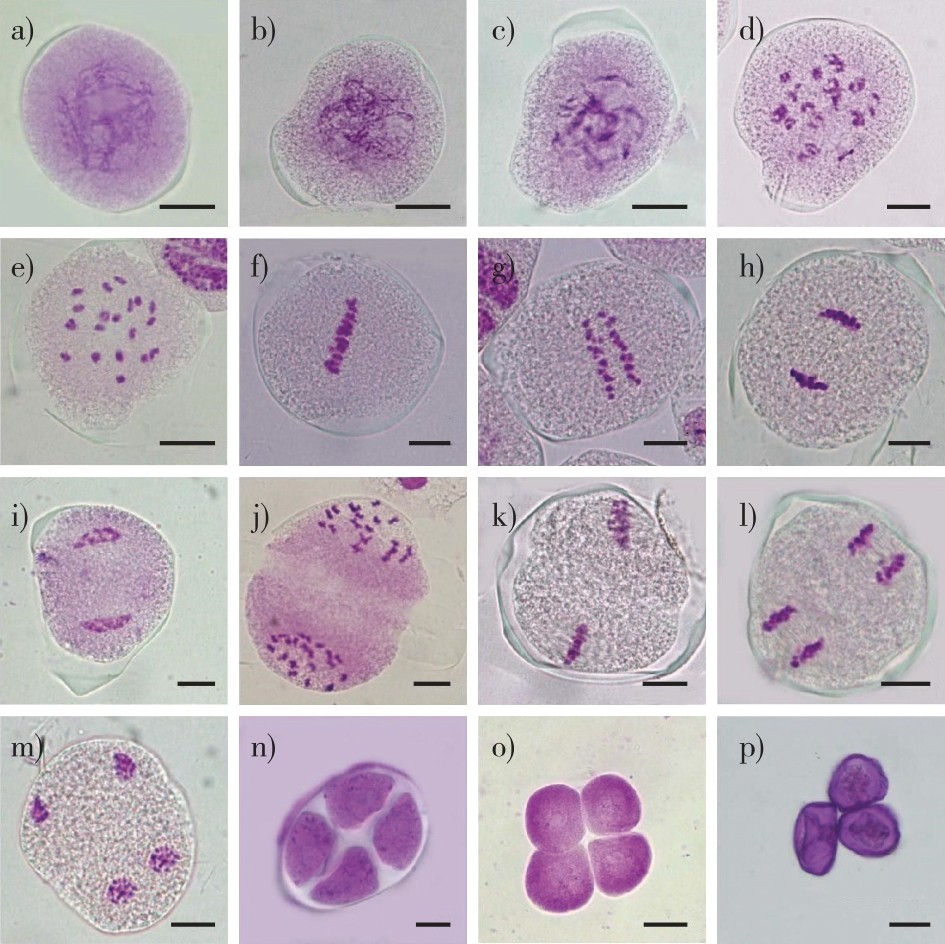 PDF(2163 KB)
PDF(2163 KB)


Meiosis and abnormal chromosomal behavior of pollen mother cells in Liriodendron ×sinoamericanum
WANG Ning, PENG Ye, CHEN Jinhui
Journal of Nanjing Forestry University (Natural Sciences Edition) ›› 2025, Vol. 49 ›› Issue (5) : 131-136.
 PDF(2163 KB)
PDF(2163 KB)
 PDF(2163 KB)
PDF(2163 KB)
Meiosis and abnormal chromosomal behavior of pollen mother cells in Liriodendron ×sinoamericanum
【Objective】Liriodendron hybrids (L. ×sinoamericanum) have excellent characteristics beyond their parents. Currently, little is known about their sexual reproduction and seed abortion mechanisms, and there are few reports on the meiosis process and chromosome behavior of their pollen mother cells. This study provides a detailed observation of the chromosomal behavior of meiosis in pollen mother cells of L. × sinoamericanum hybrids. The results can provide important cytological basis for aneuploid breeding, hybrid breeding, and germplasm resource protection of Liriodendron.【Method】The collected anthers were squashed and stained with Carbol fuchsin before microscope study. Photographs of freshly prepared slides were taken with the automatic camera of Nikon Eclipse 50i microscope. 【Result】(1) Pollen mother cells of L. × sinoamericanum can undergo normal meiosis, 80% of which can complete the meiotic process, and produce normal pollen; (2) meiosis of pollen mother cells is asynchronous. The pollen mother cells in different parts of anthers above and below the same receptacles are in different stages, and meiotic asynchrony also exists within the same pollen mother cells. (3) 20% of pollen mother cells have obvious chromosomal abnormalities in the process of meiosis, including laggard chromosomes, prematurely separated chromosomes, and micronuclei; (4) there is a diversity of spindle behavior during meiosis, with a variety of spindles, such as parallel spindles, vertical spindles and 60° or 120° spindles. 【Conclusion】Despite the abnormal chromosome behavior during meiosis of L. hybrids pollen mother cells, most of the pollen mother cells are able to complete normal meiosis and produce pollen with normal morphology, which implies that L. hybrids is an excellent material that can be used for hybrid breeding and aneuploid breeding.

Liriodendron hybrids (L. × sinoamericanum) / pollen mother cell / meiosis / chromosome / chromosamal abnormalities / spindle
| [1] |
|
| [2] |
|
| [3] |
|
| [4] |
吴伟煌, 肖保荣, 黄世清, 等. 杂交鹅掌楸F1代生长性状的基因型与环境互作效应分析[J]. 分子植物育种, 2022, 20(21):7091-7099.
|
| [5] |
| [6] |
|
| [7] |
樊汝汶, 尹增芳. 中国鹅掌楸花粉母细胞减数分裂的超微结构观察[J]. 南京林业大学学报(自然科学版), 1992, 16(2):31-36.
|
| [8] |
尹增芳, 宁代锋, 李玉春, 等. 杂种鹅掌楸花粉发育过程中细胞游离Ca2+的动态变化[J]. 林业科学, 2007(11):27-31,175-176.
|
| [9] |
徐进, 王章荣. 杂种鹅掌楸及其亲本花部形态和花粉活力的遗传变异[J]. 植物资源与环境学报, 2001, 10(2):31-34.
|
| [10] |
|
| [11] |
田菊, 牛新月, 铁英, 等. 毛新杨×银灰杨杂种花粉母细胞减数分裂及花粉形态[J]. 东北林业大学学报, 2018, 46(7):33-37,43.
|
| [12] |
李代丽, 商静, 田菊, 等. 青黑杨杂种三倍体花粉母细胞减数分裂染色体行为及其花粉变异研究[J]. 北京林业大学学报, 2019, 41(7):75-82.
|
| [13] |
|
| [14] |
|
| [15] |
|
| [16] |
尹增芳, 樊汝汶. 中国鹅掌楸与北美鹅掌楸种间杂交的胚胎学研究[J]. 林业科学研究, 1995, 8(6):605-610.
|
| [17] |
许雯婷, 赵健, 赵楠, 等. 欧洲黑杨花粉母细胞减数分裂观察及其不同步性分析[J]. 西北植物学报, 2011, 31(10):1981-1987.
|
| [18] |
|
| [19] |
|
| [20] |
|
| [21] |
|
| [22] |
|
| [23] |
|
| [24] |
|
| [25] |
|
| [26] |
|
/
| 〈 |
|
〉 |